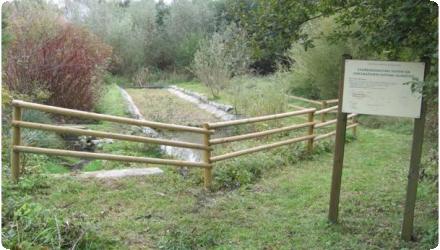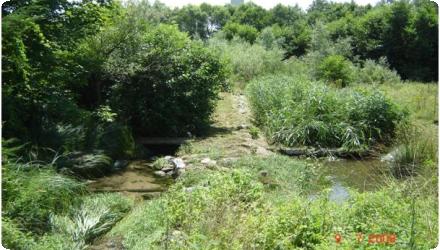Last update
2025
Summary
Installed in 2006 by Limnos Ltd., the innovative ecoremediation (ERM) system on a polluted tributary of the Glinščica combines a sedimentation pond (to settle coarse particles and reduce flow velocity), a vegetated sand-filled drainage ditch with reeds, and a short meandered channel. Early monitoring (2008–2009) reported strong reductions in nutrients and suspended matter, with effectiveness sustained by routine maintenance (including sediment removal in 2008). The facility remains in place and in use, is maintained by the City of Ljubljana, and is incorporated into local educational activities; project managers confirm it has not been amended. Since installation, additional nature-based solutions for flood retention and stormwater management have been implemented elsewhere in the Glinščica catchment - most notably the Brdnikova dry retention reservoir and works at Podutik - which have helped mitigate recent heavy-rain events. In the technical literature the site is also referenced within a broader “Multifunctional Water Reservoir (MWR) Ljubljana,” where upgrades commissioned in 2014 enhanced ecological and educational functions without changing the ERM’s treatment role.
Position
Latitude
46.0761
Longitude
14.45249
Project
NWRM
National Id
Slovenia_02
Installation date
2006-01
Implementation Status
Contact
REC
RBD code
SI_RBD_1
Transboundary
0
Photo gallery
Location of the project
This is just off Podutiška cesta near the historic Kavšek Bridge over the Glinščica. Parcels listed in the thesis: KO Glince 668, 667/1, 660/1.
NUTS Code
SI02 - Zahodna Slovenija
Project's objectives
Clean the polluted inflow using a chain of a sedimentation pond → vegetated sand-filled drainage ditch (with reeds) → short meandered channel, while slowing flow, reducing erosion, and enhancing biodiversity; also to serve education/awareness (integration in a water learning trail). No explicit numeric targets were found ex-ante, but subsequent monitoring documents substantial nutrient reductions.
Involved Partners
| Authority type | Authority name | Role | Comments |
|---|---|---|---|
Climate zone
cool temperate moist
Temperature
9,7
Precipitation
1343
Annual rainfall range
1200 - 1500 mm
Elevation range
300 m
Slope range
0-1% Average channel gradient reported as 0.006
Vegetation class
On-site treatment vegetation is emergent wetland macrophytes dominated by common reed (Phragmites australis) in the vegetated drainage ditch; the municipal page notes planting with marsh plants.
Water bodies: Ecological Status
Good
Water bodies: Chemical Status
Failing to achieve good
Water quality status
Increased pollution/toxicity in Glinščica linked to leaking septic tanks/sewer overflows, stormwater runoff, and nearby agricultural non-point sources. The Podutik reservoir/Glinščica system is affected by these inputs.
Project scale
Micro
Project scale specification
a site-specific intervention on a small tributary (sedimentation pond + vegetated ditch + short meandered reach; ERM length ~70 m), addressing local water quality/hydromorphology.
Performance timescale
< 1 year
Size
225
Size unit
m2
Total cost
€166,723
Costs total information
€166,723 for the project “Ekoremediacijski objekt na Glinščici”
€23,000 in 2011 for maintenance/monitoring and flood-related repairs at the ERM.
€23,000 in 2011 for maintenance/monitoring and flood-related repairs at the ERM.
Costs capital information
The cost was 100 Euro/m2 for investment
Costs operation maintenance information
Operation is about 30-50 Euro/m2/year
Financing authorities
Compensations
0
Policy context
Riparian development, pollution incident. a polluted tributary where urban stormwater (meteorna kanalizacija) meets a small brook carrying agricultural non-point pollution; the ERM was built to treat this inflow and restore local habitat.
Community involvment
Yes
Design consultation activity
| Activity stage | Name | Key issues | Comments |
|---|---|---|---|
|
Improved public acces
|
Policy target
| Target purpose |
|---|
|
Runoff control
|
|
Pollutants Removal
|
|
Improved Biodiversity
|
|
Oher Societal Benefits
|
Policy pressure
| Pressure directive | Relevant pressure |
|---|
Policy impact
| Impact directive | Relevant impact |
|---|
Requirement directive
| Requirement directive | Specification |
|---|
Contractual arrangements
0
| Arrangement type | Responsibility | Role | Name | Comments |
|---|
Part of wider plan
0
Wider plan type
| Wider plan type | Wider plan focus | Name | Comments |
|---|
Limnos monitored 2006–2009 for nutrients, physico-chemistry, toxicity and biota, demonstrating substantial nutrient reductions when maintenance was performed.
Multi-season programme covered BOD₅, organic N, NH₄⁺, NO₂⁻, NO₃⁻, total N, total P, plus pH, salinity, oxygen balance, temperature, specific (non-)synthetic pollutants, water/sediment toxicity, reed productivity, and plant diversity. Hydromorphology noted quantity & dynamics of flow and substrate conditions. Reported removal in the third season: NO₂⁻ 84%, NO₃⁻ 68%, total N 40%, etc.
The water level was measured at Inflow and at additional 6 sampling points in the VDD.
Outflow of the VDD and the outflow of the RBM
Maintenance
Regular municipal maintenance like mowing, debris/sludge removal and conveyance upkeep (with a key pond desilt in 2008) keeps the ERM effective.
Catchment outlet
pH, EC, DO and T were measured with portable meters WTW Multiline P4 according to Standard Methods. Hydraulic residence time (HRT) was measured with the tracer test with CaCl on 25.7.2007 and 26.7.2007. And statistical analyses.
Education & access: The City plans the ERM as part of a water learning trail; information boards and improved public access are listed measures.
Retained water
118.7 m3
Information on retained water
Creation of a sedimentation pond, a vegetated drainage ditch and a short meandered channel (≈70 m). The City states the ERM slows flow, mitigates erosion and retains water; this can help during dry periods (no volumes given).
Information on Ecosystem erosion control
Erosion increased
Water quality overall improvements
Positive impact-WQ improvement
Information on Water quality overall improvements
The results showed efficient removal of BOD5 (9%), organic N (24%), ammonia (7%), nitrites (84%), nitrates (68%), total N (40%) and total P (3%) in the entire ERM system in the third season. Vegetated ditch was efficient in removal of ammonia (38%), nitrites (91%) and nitrates (63%) and meandered stream was efficient in removal of total P (10%). With the exception of suspended and dissolved solids, pollutants concentrations at the end of the ERM system stayed within the permitted levels for outflow. The results showed the entire ERM system to be more efficient in removal of nitrites and ammonia in season 2008/2009 compared to previous year. Removal of sediments from the pond proved to be essential for efficiency of vegetated ditch, since the ditch reached higher efficiency for almost all parameters after maintenance work in the summer 2008
Water quality Improvements Phosphorus (P)
3
Water quality Improvements (P) unit
% reduction pf pollutant
Water quality Improvements Nitrogen (N)
40
Wq Improvements n unit
% reduction pf pollutant
Water quality Improvements (TSS)
SS increased
Soil quality overall soil improvements
Negative impact-SQ deterioration
System planted with common reed (Phragmites); the City reports 49 plant species recorded on the ERM and notes increasing biodiversity. (RiverWiki’s macrophyte results are marked “inconclusive”.)
Information on Other biophysical impacts
Microclimate/drought buffering: Municipality notes water retention can play an important role in dry periods (adaptation benefit). No site-specific data on evapotranspiration, greenhouse gases or carbon.
Ecosystem impact climate regulation
Not relevant for the specific application
Key lessons
Regular maintenance is decisive. Performance jumped after desilting the sedimentation pond in July 2008, showing that the ERM’s efficiency depends on routine sludge/debris removal and vegetation upkeep.
The combined design works. A staged chain—sedimentation pond → vegetated drainage ditch (VDD) → meandered reach—delivered marked nutrient reductions (e.g., NO₂⁻ −84%, NO₃⁻ −68%, TN −40%) and is a sound option for polluted run-off with variable flows. This aligns with the case’s stated lesson that a regularly maintained ERM can efficiently decrease pollutants and that the VDD+meander combo is promising.
Hydromorphology requires attention. While water-quality improved, RiverWiki notes a deterioration signal for “quantity & dynamics of flow” and “substrate conditions,” reminding practitioners to track morphology alongside chemistry and adapt the layout/operations if needed.
Long-term anchoring helps. Municipal ownership, budgeting and use as an educational stop kept the installation active and cared for years after commissioning, an underrated enabler of continuity.
Highly fluctuating inflows shape processes. Monitoring found even distribution of the denitrification narG gene across the VDD under flashy hydraulics, useful insight for similar small urban/agri catchments.
The combined design works. A staged chain—sedimentation pond → vegetated drainage ditch (VDD) → meandered reach—delivered marked nutrient reductions (e.g., NO₂⁻ −84%, NO₃⁻ −68%, TN −40%) and is a sound option for polluted run-off with variable flows. This aligns with the case’s stated lesson that a regularly maintained ERM can efficiently decrease pollutants and that the VDD+meander combo is promising.
Hydromorphology requires attention. While water-quality improved, RiverWiki notes a deterioration signal for “quantity & dynamics of flow” and “substrate conditions,” reminding practitioners to track morphology alongside chemistry and adapt the layout/operations if needed.
Long-term anchoring helps. Municipal ownership, budgeting and use as an educational stop kept the installation active and cared for years after commissioning, an underrated enabler of continuity.
Highly fluctuating inflows shape processes. Monitoring found even distribution of the denitrification narG gene across the VDD under flashy hydraulics, useful insight for similar small urban/agri catchments.
Success factor(s)
| Success factor type | Success factor role | Comments | Order |
|---|---|---|---|
|
Existing technical standards
|
main factor
|
||
|
Attitude of relevant stakeholders
|
secondary factor
|
Structured monitoring (2008–2009) enabling adaptive management and evidencing results. |
Driver
| Driver type | Driver role | Comments | Order |
|---|---|---|---|
|
Organisation committed to it
|
main driver
|
Dedicated municipal role (Mestna občina Ljubljana) with ongoing care and public-facing use (learning trail).
|
Transferability
Highly transferable to small, mixed-pollution tributaries and stormwater outfalls. Success hinges on routine O&M (esp. desilting the pond), capacity to manage flashy inflows, and space for a pond-VDD-meander chain. Watch solids loads, upstream sewer/agri pressures, and potential hydromorphology trade-offs; keep monitoring nutrients/physico-chemistry to adapt.
Source(s)
English




Timely maintenance, especially the 2008 desilt that restored treatment efficiency.